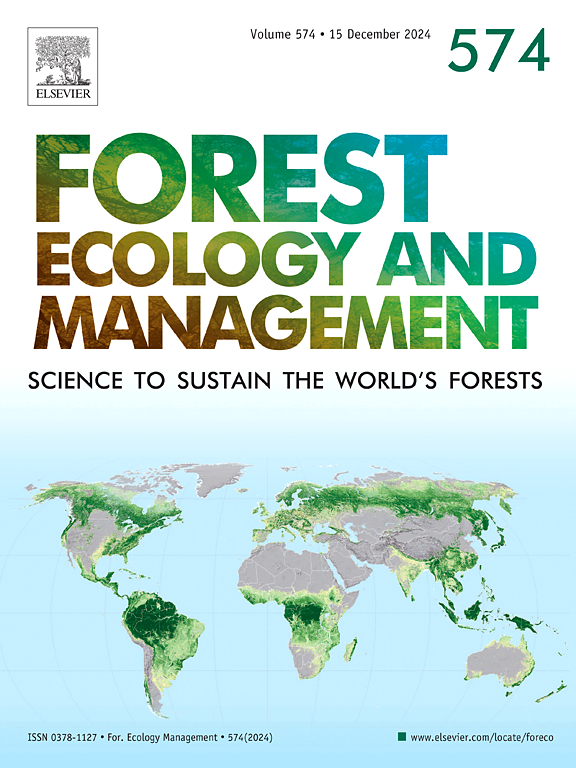Modeling European beech defoliation at a regional scale gradient in Germany from northern lowlands to central uplands using geo-ecological parameters, Sentinel-2 and National Forest Condition Survey data
IF 3.7
2区 农林科学
Q1 FORESTRY
引用次数: 0
Abstract
Since 2018, severe droughts have affected a significant part of central Europe, causing premature leaf senescence in European beech (Fagus sylvatica L.). The correlation between the vitality of Fagus sylvatica L. and various geo-ecological and biological determinants (such as elevation, slope, aspect, tree age, and soil properties) concerning hydrological drought stress is still not well understood, especially when integrating multiple geographical datasets. In addition, the determination of crown condition by remote sensing and geo-ecological parameters is still under development; it would allow the assessment of an area-wide forest health status. Our analysis incorporated annual field data from the German National Forest Condition Survey (Waldzustandserhebung, WZE) as a response variable and employed geo-ecological parameters derived from a digital elevation model, soil properties and vegetation indices from a Sentinel-2 time series to explain and predict the crown defoliation of European beech throughout the drought-impacted period spanning 2016–2022 across the federal states Schleswig-Holstein, Lower Saxony, and Hesse of Germany. In a second step, the results of the modeling were used for mapping of crown defoliation in Hesse, Lower Saxony and Schleswig-Holstein. By employing Gradient Boosting Machines and Random Forest for regression analysis, the study uncovered the relationships between crown defoliation and the used predictors. Training was conducted on 80 % of the dataset, with the remaining 20 % serving as a test set for model validation. Regression findings based on static explanatory variable sets were improved by dynamic explanatory variables such as estimates of soil moisture, vegetation index metrics, and diameter at breast height. Furthermore, we identified key predictors for mapping crown defoliation of Fagus sylvatica L. and recommended using vegetation indices as additional predictors for future studies. The modeling results provided comparably accurate estimates compared to WZE estimates (R2 of 0.794 and RMSE of 7.646 %) during testing. Topographic and static soil predictors were significant, with soil moisture being a particularly influential variable for model optimization. Based on the predicted crown defoliation, beech trees with low to moderate crown defoliation predominated in beech distribution areas across the examined federal states, while a small number of beech trees with high defoliation were identified mostly in South Lower Saxony and Hesse. The annual variations in the proportions of beech trees showing increasing and decreasing crown defoliation indicate that the condition of the crown temporarily deteriorated when soil moisture decreased, but beech trees recovered after prolonged periods of drought. Additionally, beech trees in the study region exposed to declining soil moisture may suffer from medium-term declines in vitality. The predicted crown defoliation data can be utilized for future climate-adaptive management practices in European beech forests.
利用地理生态参数、哨兵-2 和国家森林状况调查数据,模拟德国从北部低地到中部高地区域尺度梯度上的欧洲山毛榉落叶情况
自 2018 年以来,严重的干旱影响了欧洲中部的大部分地区,导致欧洲山毛榉(Fagus sylvatica L.)叶片过早衰老。欧洲山毛榉(Fagus sylvatica L.)的生命力与有关水文干旱胁迫的各种地理生态和生物决定因素(如海拔、坡度、地势、树龄和土壤特性)之间的相关性仍未得到很好的理解,特别是在整合多个地理数据集时。此外,通过遥感和地理生态参数确定树冠状况的方法仍在开发中,这将有助于评估整个地区的森林健康状况。我们的分析纳入了德国国家森林状况调查(Waldzustandserhebung,WZE)的年度实地数据作为响应变量,并采用了数字高程模型、土壤特性和哨兵-2 时间序列中的植被指数得出的地理生态参数,以解释和预测德国石勒苏益格-荷尔斯泰因州、下萨克森州和黑森州在 2016-2022 年整个干旱影响期间欧洲山毛榉的树冠落叶情况。第二步,将建模结果用于绘制黑森州、下萨克森州和石勒苏益格-荷尔斯泰因州的树冠落叶图。通过使用梯度提升机和随机森林进行回归分析,研究发现了树冠落叶与所用预测因子之间的关系。对 80% 的数据集进行了训练,其余 20% 作为模型验证的测试集。基于静态解释变量集的回归结果通过动态解释变量(如土壤湿度估计值、植被指数指标和胸径)得到了改善。此外,我们还确定了绘制欧洲鼠尾草树冠落叶图的关键预测因子,并建议在今后的研究中使用植被指数作为额外的预测因子。在测试过程中,建模结果提供了与 WZE 估计结果相当准确的估计值(R2 为 0.794,RMSE 为 7.646 %)。地形和静态土壤预测因子都很重要,其中土壤湿度是对模型优化特别有影响的变量。根据预测的树冠落叶情况,在所考察的联邦各州的榉树分布区中,树冠落叶率低至中等的榉树占多数,而少数落叶率高的榉树主要分布在南下萨克森州和黑森州。榉树树冠落叶量增加和减少的比例每年都有变化,这表明土壤水分减少时树冠状况会暂时恶化,但长期干旱后榉树又会恢复。此外,研究地区的榉树在土壤水分下降时可能会出现中期生命力衰退。预测的树冠落叶数据可用于欧洲山毛榉林未来的气候适应性管理措施。
本文章由计算机程序翻译,如有差异,请以英文原文为准。
求助全文
约1分钟内获得全文
求助全文
来源期刊

Forest Ecology and Management
农林科学-林学
CiteScore
7.50
自引率
10.80%
发文量
665
审稿时长
39 days
期刊介绍:
Forest Ecology and Management publishes scientific articles linking forest ecology with forest management, focusing on the application of biological, ecological and social knowledge to the management and conservation of plantations and natural forests. The scope of the journal includes all forest ecosystems of the world.
A peer-review process ensures the quality and international interest of the manuscripts accepted for publication. The journal encourages communication between scientists in disparate fields who share a common interest in ecology and forest management, bridging the gap between research workers and forest managers.
We encourage submission of papers that will have the strongest interest and value to the Journal''s international readership. Some key features of papers with strong interest include:
1. Clear connections between the ecology and management of forests;
2. Novel ideas or approaches to important challenges in forest ecology and management;
3. Studies that address a population of interest beyond the scale of single research sites, Three key points in the design of forest experiments, Forest Ecology and Management 255 (2008) 2022-2023);
4. Review Articles on timely, important topics. Authors are welcome to contact one of the editors to discuss the suitability of a potential review manuscript.
The Journal encourages proposals for special issues examining important areas of forest ecology and management. Potential guest editors should contact any of the Editors to begin discussions about topics, potential papers, and other details.
 求助内容:
求助内容: 应助结果提醒方式:
应助结果提醒方式:


